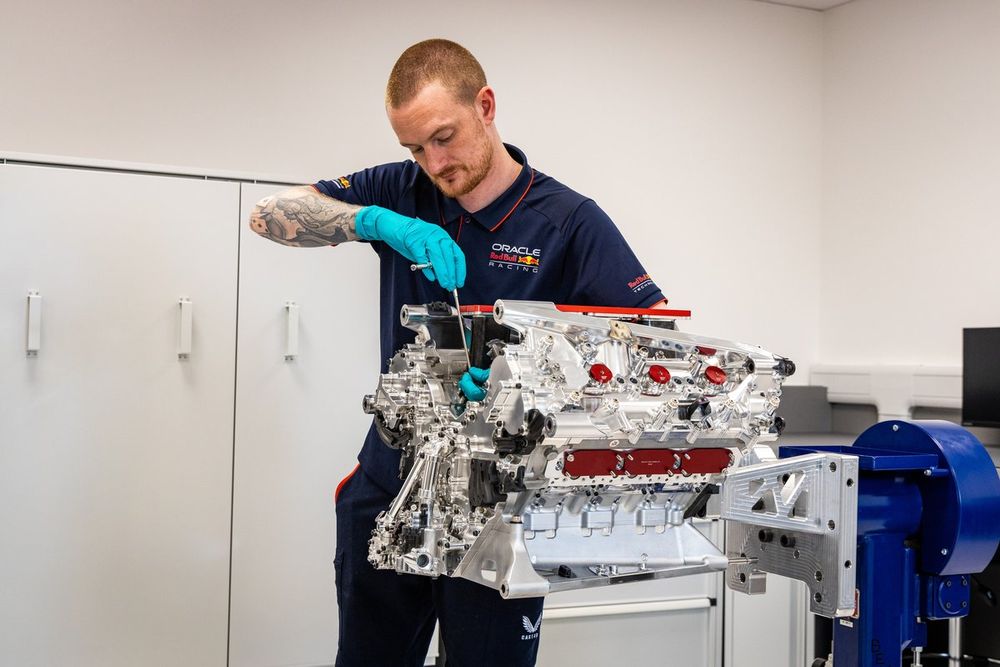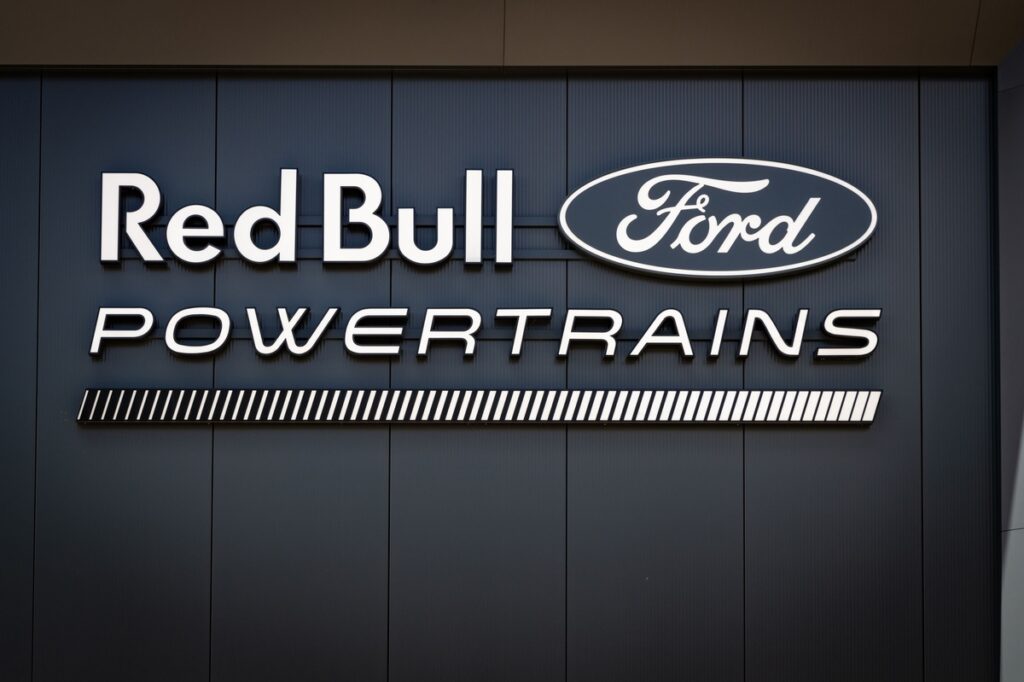The story of Ford’s return to Formula 1, from Red Bull’s point of view, is well known by now.
The Milton Keynes-based team held lengthy talks with Porsche to develop a works engine for the all-new 2026 power unit regulations, but those ultimately collapsed. The German sports car brand was keen on becoming an equal partner, including shares, but Red Bull feared losing control. And given the involvement of the Volkswagen Group – and its myriad layers of governance – Red Bull was also wary of losing its agile decision making.
Ford observed the breakdown of Red Bull’s negotiations with Porsche with keen interest and immediately saw an opportunity. “It became very clear that, at least from what we saw from the outside, that it was not going to work for Red Bull with Porsche”, Ford Motorsports director Mark Rushbrook told Motorsport.com. “I literally got Christian Horner’s email address, sent him an email and said ‘Hi, do you want to talk?’”
It led to the first conversations, about which Horner shared an amusing anecdote: “We went to a meeting at Dearborn on the way to Brazil, and met with yourself, Bill Ford and Jim [Farley]. I thought we were in good shape when Jim walked into the meeting with a Sergio Perez cap! I thought ‘Okay, we are looking pretty good here!’ You could just feel that there was a real enthusiasm from the very top of the company, from Bill Ford, who was so enthusiastic about coming back to Formula 1, and Jim, who is a racer himself.”
Things started moving quickly, although the question remains why Ford specifically chose Red Bull for its new chapter in Formula 1. Ford has a rich history in the series, including the once-omnipresent Cosworth DFV engines, although it had been absent since late 2004 when it sold the Jaguar team to none other than Red Bull.
The growing popularity of the sport and the 2026 regulations both played their part swaying opinions at the Michigan headquarters. “If you would have asked me five years ago, and actually people did ask me, ‘Is Ford going to get back into Formula 1?’ then my answer was no. At the time we didn’t think that F1 was the right place for us, but certainly things have changed afterwards”, Rushbrook said.
“If you see how the regulations are written down for 2026 with the increase of the electrification, with the fuel changes and with the commitment to be net-zero by 2030, that aligns with a lot of our values and what is important for us. The growth of the sport plays a role as well. We go racing for innovation and for tech transfer, so transferring technology from the racetrack to the road and, if possible, the other way around as well. We also want to go racing for the ability to tell the story of our company, our people and our products. Three years ago, it became clear that things were changing and that we needed to take a serious look at Formula 1 again. And here we are.”
Ford considered buying its own team
But between the ambition of returning to F1 and actually signing a deal, there is still the step of weighing up all the options. Rushbrook revealed that Ford also looked at other options once it was clear that the company wanted to return to F1, including the possibility of buying an existing team.
“Before we had this deal with Red Bull, there were a lot of discussions going on,” he explained. “Some Formula 1 teams approached us, and we approached some teams as well. We needed to understand the landscape and the different ways to get into the sport.
“We even looked at ‘Okay, should we buy a team ourselves?’ I think we demonstrated by what this team has become, what used to be Jackie Stewart Racing and Jaguar, that this is not our core competency, right? Yes, we are in motorsports, but nowhere do we own or run a team. We always go with partners, whether it’s Dick Johnson racing in Australia, Penske in NASCAR, Bob Tasca in NHRA or M-Sport in rally.
“You can go and do your own power unit entirely by yourself or you could come in as just a customer power unit, but then Ford doesn’t have anything invested into a team itself. As soon as we saw this as an opportunity, it became clear very quickly that it was the right way to go. This opportunity allows us to partner with what we believe is the best team in the series. We are complementary, and for us that is the right way to do it.”
What is Ford actually contributing?
The big question in those early conversations was what Ford could actually bring to the Red Bull programme other than a badge and its chequebook, and how the power unit programme would be run between the two partners, with work already well under way at the team’s in-house Red Bull Powertrains division.

My first question to Christian was ‘What are you looking for in a partner?’ and I was prepared to say what we were looking for in a partner. In the first 20 minutes of that discussion there was a very broad alignment,” Rushbrook recalled. “In that first meeting we also outlined the areas where Red Bull Racing needed help with the power unit and with the racing team, and the areas where we wanted to contribute and learn. That process continues today, although the list is longer today than during those initial discussions.”
After the first meeting, the idea was that Ford would mainly help with the electrical parts of the 2026 engine, although Rushbrook emphasizes that more is happening behind the scenes. “Additive manufacturing is a good example of that. We have good resources and materials for it. That wasn’t on the initial list, but it is happening now. The same goes for contributing to the internal combustion engine and the turbo. Those things weren’t on the initial list either, but there is a lot of knowledge that we have with modelling and testing that can help Red Bull.”
According to Rushbrook, it underlines that Ford isn’t just in it for the marketing exposure but also for the aforementioned tech transfer to its road cars. “Our main focus is on the electrification, the battery cell chemistry, the battery pack, the motor, the inverter, but also in the controls and the software. That is a big opportunity for us.”
It’s a way of working that is completely different compared to what Red Bull initially discussed with Porsche, Horner pointed out. “From the outset Mark and Jim Farley said ‘You guys do Formula 1 every day. That’s your bread and butter. We’re not going to impose our methodology on you. You tell us, how can we help? Where can we assist?’ It was very much an open book. It feels like a partnership that you’re not imposing on the engineers, which sometimes happens in these relationships, and what we were fearful of in the other option we were looking at.”
The spirit of Mateschitz: ‘No risk, no fun’
How competitive the end product of that collaboration will be in 2026 is still unknown, although Horner admitted that he was under no illusion that the first year will be plain sailing. But he also sees an advantage for Ford, as the brand might not get publicly judged too harshly because in the current set-up it doesn’t have full responsibility over the engine. “It’s a bit like being grandparents”, Horner joked. “You get all the benefits of the kid and all the upsides, but then you give it back to the parents and you don’t have the sleepless nights and you don’t have to change the nappies, so there is a kind of analogy there.
“For us it’s just exciting to have the Blue Oval back in Formula 1. Of course, there’s risk associated with what we are doing. Taking on and doing what we are doing is insane in terms of the investment and producing our own engine, but as Dietrich Mateschitz always told us: ‘No risk, no fun’. That applies to this project, and it’s something we couldn’t have done without a like-minded partner.”
In this article
Ronald Vording
Formula 1
Max Verstappen
Liam Lawson
Christian Horner
Red Bull Racing
Be the first to know and subscribe for real-time news email updates on these topics
Subscribe to news alerts
Read the full article here

